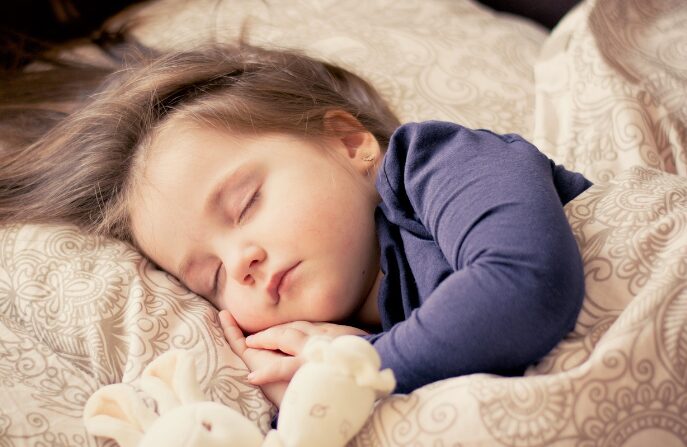Bedwetting Alarms for Kids: What You Need to Know

Even though some might say otherwise, it’s perfectly normal for older children to have accidents at night. Bedwetting can happen to kids of any age, and even some adults, but that doesn’t mean we shouldn’t look for ways to help our child.
Bedwetting can be embarrassing and make children feel ashamed. They might still need pull-ups at night, and we may often have to change their sheets in the morning.
While searching for a solution, you might come across a bedwetting alarm and wonder if it could help.
A bedwetting alarm is worn on the body and has a sensor that detects moisture. When it senses wetness, it triggers an alarm to wake the child so they can go to the bathroom.
What Is Nocturnal Enuresis?
Chronic bedwetting, also referred to as nocturnal enuresis (NE), is a kind of urine incontinence in which a person unknowingly wets their bed while sleeping.
NE generally affects children over the age of five who wet their beds at least twice a week for three months or more. Although it may affect children, teenagers, adults, and the elderly, it is more frequent among youngsters. In fact, it is the most often discussed concern among parents of children with urine incontinence (UI).
Here’s what research says about NE in various age groups:
- Five years: 20%
- Seven years: 15%
- Ten years: 10%
- Teens: 2%
- Adults: 0.5 – 1%
NE is more prevalent in males than in girls.
What Causes Bed Wetting
Genetics:
Children with NE often inherit the disease from their parents. Studies show:
- 44% of children with NE had at least one parent who wet the bed as a youngster.
- 77% of children with NE had both parents who were bedwetting when they were younger.
Psychological Factors:
PTSD, stress, terror, and sexual abuse may all produce NE in children.
Lifestyle Choices:
Diet and toilet habits may also contribute to NE.
Other conditions:
Certain health conditions may cause NE in children, including:
- Constipation
- Cystitis
- Diabetes insipidus
- Low amounts of antidiuretic hormone (ADH)
- Medical issues (such as spina bifida)
- Neurological problems (such as autism and ADHD)
- Overactive bladder (OAB)
- Sleeping problems
- Small bladder capacity
- Urethral blockages
- Urinary tract infections (UTI)
What Is a Bedwetting Alarm?
A bedwetting alarm, often known as an enuresis alarm, may help children quit bedwetting.
The alarm detects pee using a moisture sensor. When your kid begins to wet the bed, the sensor activates the alarm to wake them up and avoid further mishaps.
Hobart and Willie Mowrer designed these alarms in 1938. Their first concept included a bed pad with an electrical connection that sounded a bell when urine touched it.
Today, there are several varieties of pee alarms to meet diverse demands. Modern alarms rely on a moisture sensor put in your child’s pajamas or on their arm. When the sensor detects even a small quantity of pee, it sounds an alarm to wake your kid so they may use the restroom. Some alarms are loud enough to wake up parents, allowing them to aid their children.
While most alarms have similar characteristics (moisture sensor, volume control, wearable style), their prices range from $50 to more than $150.
Types of Bedwetting Alarms
There are several various types of bedwetting alarms, so select the one that works best for your family. Here is a glance at the three major types:
-
Wired Bedwetting Alarm
This alarm connects the sensor to the alarm unit via a wire. The alarm is positioned near the child’s shoulder so that they can hear it when it goes off, and the sensor detects moisture in their underwear. When the sensor detects wetness, an alarm rings to alert the youngster.
-
Wireless Bedwetting Alarms
This alarm does not need any wires, making it an excellent choice for children who wander about often at night. Rather than producing a sound, the sensor vibrates to inform the youngster. However, this may not be effective for profound sleepers since the vibration may be insufficient to awaken them.
-
Bell and Pad alarms
The original pee alarm was a bell and pad. It works by placing a moisture-sensitive pad underneath your youngster as they sleep. When the pad becomes wet, an alert sounds.
This style is comfy since your youngster does not need to wear anything while sleeping. However, it may not function as well as wearable or wireless alarms. If your kid wanders away from the pad while sleeping or does not wet the bed sufficiently for the pad to detect, the alert may not sound.
How Do Bedwetting Alarms Work?
Bedwetting alarms go off when they detect the first drop of pee. The objective is for your kid to wake up when they hear the alarm, go to the toilet, and finish urinating there.
After using the alarm for six to eight weeks, your youngster should be able to wake up without it or hold it till morning.
Approximately 70% of youngsters cease wetting their beds while using the alarm, and approximately 50% remain dry at night after completing the program.
Factors to Consider Before You Buy a Bedwetting Alarm
Before purchasing a bedwetting alarm for your kid, examine the following four questions to determine if it will be effective:
-
Do you know why your kid wets the bed?
If your kid has particular needs, constipation, urinary tract infections, or sleep disorders, a bedwetting alarm may not be effective. It is a good idea to consult your child’s doctor to determine what is causing the bedwetting.
-
Is your youngster ready?
Make sure your youngster is prepared to utilize the alarm. This will help them achieve while also reducing any anxiety or frustration caused by the alert. Talk to your kid about using the alarm and see if they agree.
-
Do you know what kind of alarm to choose?
Different alarms serve different purposes. For example, if your kid is older and prefers a quiet vibrating alarm, or if they have a sleep issue that makes it difficult to hear noises, choose an alarm that meets their requirements. If you are uncertain, consult your child’s doctor.
-
Are you prepared to help?
Treatment for bedwetting might take time. Prepare to be patient and available to assist your kid throughout the process, including staying up longer at night to support them.
Bedwetting Alarm Tips for Beginners
Helping your kid with bedwetting takes time, and utilizing a bedwetting alarm is just one step. Here are some recommendations for starting:
-
Talk to your child
Inform your youngster that the alarm is there to aid them, not to penalize or shame them. Allow them to set up the alarm and practice using it a few times so they get used to the sound.
-
Use backup products
If your child’s bed remains wet or the alarm does not function, try utilizing nighttime diapers or pull-ups. Check to see if your child’s insurance or the state gives any free things.
-
Set up a nightlight
Place a nightlight or flashlight in your child’s room to make it easier for them to locate the bathroom when the alarm rings.
-
Be prepared to help
Your youngster may not wake up right away when the alarm goes off. Be prepared to assist them in turning off the alarm, going to the restroom, or changing the bedding as required.
-
Use the alarm every night
Try using the alarm every night for 3-4 weeks or until your kid is dry. If you do not observe any improvement, contact their doctor.
-
Clean the alarm
Follow the cleaning directions on the alarm to keep it safe for your kid.
-
Be supportive
Bladder retraining may be difficult. Encourage your youngster and provide good encouragement. Consider implementing a reward system to assist and inspire them.





